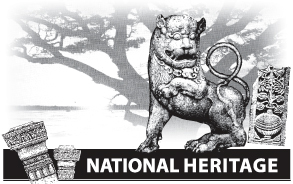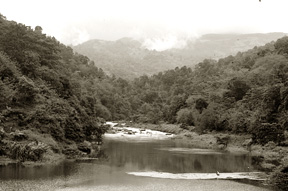|
observer |
|
|
|
|
|
OTHER LINKS |

|

|

|
'Thumpath ratawai Dumbara kethe nelum'
At Tennekumbura, the Kandy-Mahiyangana road divides. The one which turns to your left along the bridge over the river Mahaweli runs via Digana, Teldeniya, Hanguranketa, Hunnasgiriya, and through several other remote villages in Dumbara Valley. The main itinerary of many visitors to Kandy could be paying homage to the sacred temple of the tooth relic and witnessing a grand collection of plant life at the Royal Botanical Garden in Peradeniya. But the hill country that is bestowed with all natural beauty, cultural heritage, historical values and traditional way of life would definitely offer values to the visitor of many places of interest, thereby giving them the opportunity for recreation, holiday, pilgrimage, education, information, research and tourism.
Kandy was the last strong hold of the local Kings until the country fell on the British in 1815. Since then, the city remains as the cultural capital of the country for its rich heritage of local culture, Buddhist temples, and shrines of gods and traditional life style of people. History records that many ancient Sinhala Kings sought refuge in the hill country especially for its strategic balance such as thick forests, rock terrains, water-ways and other natural hideouts like rock caves that prevented the enemy reaching the targets easily. Dumbara Valley is first among such hiding places for ancient Kings as many of them had to flee time to time from their local or foreign enemies in order to save their lives as well as their family members. Having defeated the enemies and occupying the Throne, some Kings, those grateful to the people built temples, dagobas, devales and shrines as a mark of respect to the places which provided them with refuge to regroup. Hundreds of such places of worship today stand as sacred sites immensely demonstrating the living history of the Kandyan Kingdom - an era of vicissitudes - mixture of political turbulence and socio economic prosperity. Among such popular places built by ancient Kings and often visited today are Degaldoruwa Viharaya, Pitiye Devalaya in Dambarawa, Galmaduwa Viharaya, Palace site Kundasale, Kundasale Viharaya, and Bambaragala Viharaya. All of them are located in the close proximity of Digana. During the times of the Kandyan Kings, all prime ministers who were known as Maha Adikaramas were chosen from Patadumbara Pallegama and were known as Maha Nilames. Two of these prime ministers were Meegastenne and Pilimatalawe, Professor Anuradha Seneviratne writes in his book 'Kandy' published by the Central Cultural Fund. The Dumbara valley, situated in the central hills of Sri Lanka beyond the ancient Kingdom of Kandy, had its early mention in the 13th century when King Wickremabahu III moved his capital from Gampola. For 50 years he reigned the country until King Buvanekabahu V took over his Kingdom to Kotte. It is recorded that the King of Kurunegala, prior to the 13th century, moved to the Dumbara valley to avoid invasion by the Kings of Jaffna and to take advantage of the extremely rich soil and the moderate rainfall of this valley, conducive to agricultural civilisation.
Despite these treasure troves of history, culture, natural beauty and traditional agriculture, Dumbara Valley still rests behind the curtain of the Kandyan show piece. May be it was hidden in the visitor's eye due to lack of publicity or due promotion is not given by the respective authorities, Dumbara Valley is worth visiting for its pristined beauty, culture and soothing environment. Dumbara folk art provides much evidence to prove the way of life of the people in Dumbara Valley and the following folk poem bears testimony to its livelihood, beautiful women and the farming methods: Dumbara kete veta bendala rakum balum Even today, many residents in the villages of Dumbara are farmers. The Victoria Reservoir project which submerged the ancestral property of many families deprived the farming community in Dumbara of the life they led in content. However, the rest of the farmers and traditional craftsmen still produce the finest tea in Dumbara and manufacture intricate art and craft items to the local tourist market and for the export market. Many families, descendants of drummers, dancers and other stakeholders directly participate in the annual Esala Perahera, and many of them find homes in the villages of Dumbara. Kalapuraya is a witness to the traditional craftsmanship of Dumbara valley. Eight kilo metres from Kandy, this craft village is a centre of attraction where descendants of the master craftsmen still create art and craft of rare elegance using metal, wood and leather. Among their souvenir items are in wood, copper, silver, brass, ebony and bronze. Ceramics, lacquer work, handlooms, batiks, jewellery and rush and reed-ware with intricate designs can be bought in Kalapuraya. However, the new development with the advent of the Victoria project in 1970s has gradually opened the gates of Dumbara to the outside world. Mahaweli Raja Mawatha was built and motorists found the road convenient to reach Mahiyangana and hotels, gold courts and such leisure trade activities taking place in the area. The Pallekele Industrial Zone and the Stadium were established thus giving the neglected area a new lease of life. To the North Eastern side of Dumbara Valley, the Knuckles Mountain Range, with its four distinct elevations adds absolute charm to the already spectacular view. It is no wonder that the finest tea produced in the Knuckles is wonderful and tasty. The Knuckles Mountains provide splendid trekking paths for the adventurous hikers and animal and plant lovers. |
 The sounds of 'tom' 'tom' beating for the morning pooja of the daily
ceremonies of homage to the sacred Tooth Relic at the Sri Dalada
Maligawa was still echoing through the hills. Passing the Maligawa
precincts and the Pattirippuwa on the left along the Dalada Veediya, a
giant Iron Gate at the entrance to the Dharmapala Mawatha stands strong
welcoming motorists to the hill country's most scenic spectacle, Dumbara
Valley.
The sounds of 'tom' 'tom' beating for the morning pooja of the daily
ceremonies of homage to the sacred Tooth Relic at the Sri Dalada
Maligawa was still echoing through the hills. Passing the Maligawa
precincts and the Pattirippuwa on the left along the Dalada Veediya, a
giant Iron Gate at the entrance to the Dharmapala Mawatha stands strong
welcoming motorists to the hill country's most scenic spectacle, Dumbara
Valley. 









